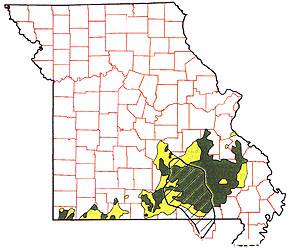Pond Pine, close to a pond
(reflections are of Eastern White Pine)
Pearson Creek
"Prosperity is a great teacher; adversity is greater." -- William Hazlitt
Pine Trees Suitable For Southwest Missouri
Pond Pine, close to a pond
(reflections are of Eastern White Pine)
Pearson Creek
The indigenous shortleaf pine belt of Missouri, before its destruction by European immigrants in the two decades before and after 1900, covered a four to six million acre area which was east of the Springfield Plateau and south of (and including part of) the Salem Plateau. This is approximately the east-central one-fourth of the southern one-third of the state. This includes about half of the physiographic division known as the Ozarks. Early descriptions (esp. Henry Rowe Schoolcraft) indicate that the Springfield Plateau was oak-hickory savannah, gradually transitioning to prairie further west. The Pearson Creek Unit of the Lovett Pinetum is situated in the mid-Springfield Plateau, which illustrates the indigenous pine growth is not a prerequisite for successful pine culture. In fact, the area is well adapted to growing a large number of pine species.

Missouri Indigenous Shortleaf Pine Distribution (courtesy of The
Nature Conservancy of Missouri)
(Yellow= Mixed Oak-Pine; Green= Shortleaf Pine Only)
The climate in this area is classified as Koppen type Cfa (the letters respectively indicate: C = coldest month average temperature between 27 degrees F. and 65 degrees F.; f = sufficient precipitation each month; a = warmest month average temperature above 72 degrees F.). This certainly imposes no difficulty for pine culture. However, some limitation does arise from our mid-continental location and moderately cold winters, indicated by U.S.D.A. Hardiness Zone of 6a (average wintertime low temperature of -5 to -10 degrees F.). This is probably the single most limiting factor in the number of pine species viable on a long-term basis here. The further south (i.e., Arkansas and East Texas) of here, the greater the overall advantage for pine trees. The hardiness zone given for a given species is often more of an opinion than a fact, but most (not all) trees classified zone 8 or higher will ultimately die here in the winter. Summertime temperature highs in the mid-90's eliminates a few species of pines, but not nearly as many as the coldness of the winter.
Soils over either limestone or sandstone bedrock are suitable, but most pines prefer the well drained sandy soils. Site suitability judgement is essential but also has significant unpredictability, so there is no wisdom that will ever completely replace the trial and error approach. Generally it is better long-term to have selected a site that is on the dry side and which requires watering for the first few years over a wetter site, even though early growth rates may be better in the latter. Early rapid growth is not well correlated with long-term success. Also even though the genus Pinus generally loves full sun, afternoon shade is very desirable and often essential for young pine trees.
North American pine trees suitable for southwest Missouri (generally this is applicable to all of southern Missouri and northern Arkansas), classified on the experience of the Lovett Pinetum, are:
All pines listed under category C have failed here despite special treatment.
Hopefully new species will be discovered or a species in category C will be promoted to A or B status, but surely more of them will be demoted to category D.
Even with trees in categories A and B, one may be required to render routine care and to occasionally treat specific diseases or insect problems. Consult your local extension agent or the Missouri Department of Resources (573-751 4115).
In a few years, the Lovett Pinetum should be able to provide advice for S.E. Texas and the western slope of the Sierra Nevada in California. Pine trees grow slower than us, so it takes time!
Any pine culture experience that is different from our experience may be reported to us at the email address on the home page and your input will be appreciated. The Pinetum wishes you success!
PSSSSSSSSSSSST! Wanna hear about some non-pine conifers that are easy to grow in S.W. Missouri and are beautiful?
O.K., try these :
You may see pictures of most of these trees, growing in S.W. Missouri, in the following file... (Go to file #37. SW MO Conifers (Non-Pine) pix).
Although these are not pines (some are in the pineaecae family), they are extremely beautiful trees and reasonably easy to grow in SW Missouri.
AND, if you think you want a real challenge, try the Giant Sequoia (Sequoiadendron giganteum) which is very difficult (unless you know THE secret). The secret is to select the 'Hazel Smith' cultivar and to plant it as far from our native junipers as possible.